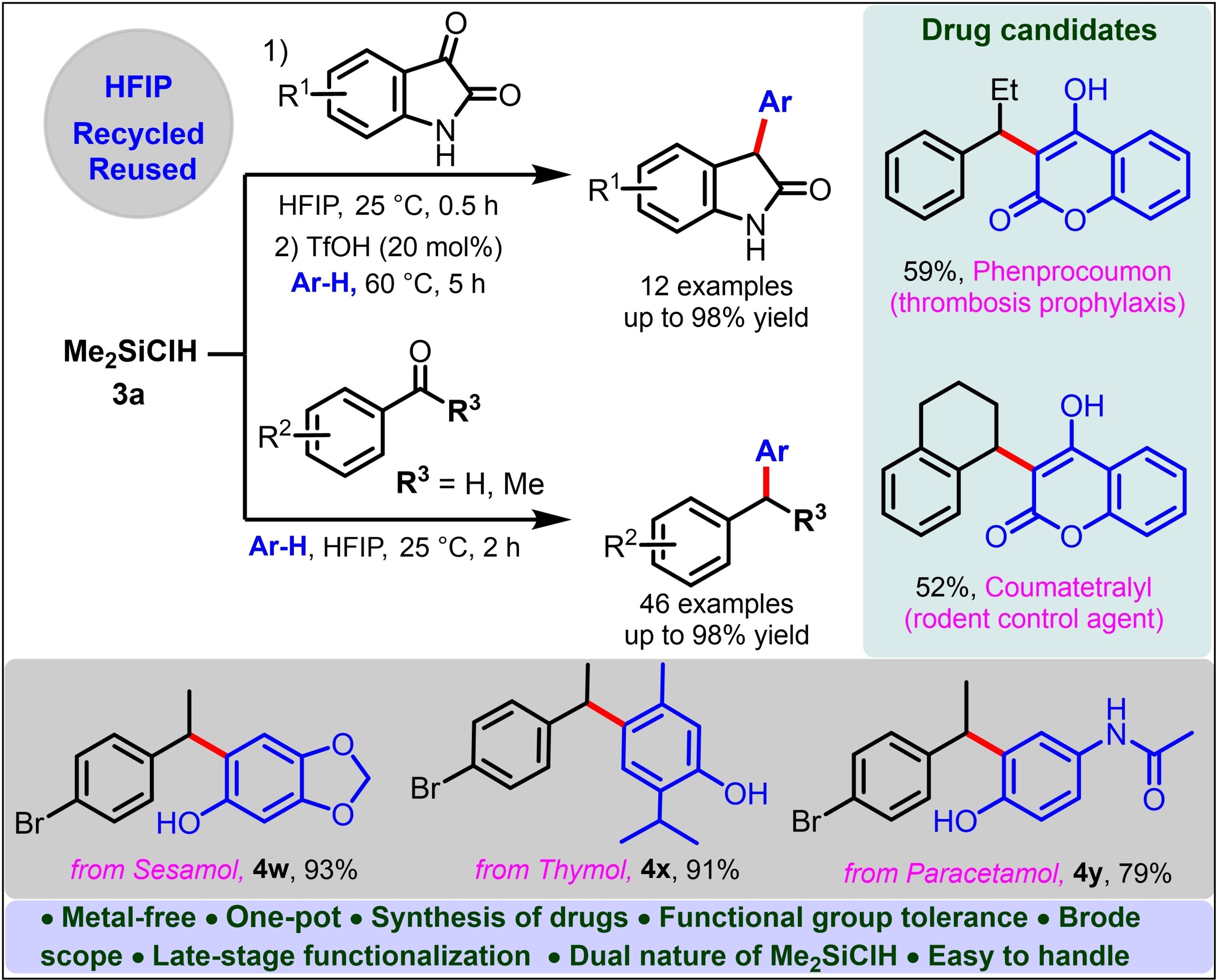硅烷通过羰基化合物的还原 Friedel-Crafts 反应介导的烯烃烷基化反应
IF 2.8
4区 化学
Q1 CHEMISTRY, ORGANIC
引用次数: 0
摘要
在 1,1,1,3,3,3,- 六氟异丙醇 (HFIP) 溶剂中,通过还原性 Friedel-Crafts 烷基化羰基化合物制备 1,1- 不对称二芳基烷烃的无金属一锅合成路线已经得到证实。这种方法具有广泛的底物范围,可容纳多种功能。通过二甲基氯硅烷(Me2SiClH)还原,再通过亲核攻击烷烃,可将羰基化合物转化为烷基化产物。所建立的方案展示了一种将吲哚啉-2,3-二酮高产率转化为α-芳基氧吲哚的可行策略。该反应包括先用 Me2SiClH 还原,然后在 TfOH 催化剂存在下进行烷烃反应。所设计的方案具有可扩展性和对各种官能团的显著耐受性。对照实验深入揭示了反应机理,指出了离子途径,并强调了 HFIP 和 Me2SiClH 的关键作用。此外,该方法还适用于多种天然产品和药物的后期官能化,如芝麻酚、百里酚、扑热息痛、薄荷醇和橙花醇。值得注意的是,该技术已被证明能有效合成抗凝血药物 Phenprocoumon 和灭鼠剂 Coumatetralyl。本文章由计算机程序翻译,如有差异,请以英文原文为准。

Silane‐Mediated Alkylation of Arenes via Reductive Friedel‐Crafts Reaction Using Carbonyl Compounds
A metal‐free one‐pot synthesis route has been documented for the production of 1,1‐unsymmetrical di‐aryl alkanes via reductive Friedel−Crafts alkylation of arenes with carbonyl compounds in 1,1,1,3,3,3,–hexafluoroisopropanol (HFIP) solvent. This approach exhibits a wide substrate scope accommodating diverse functionalities. The transformation of carbonyl compounds into alkylated products is facilitated by dimethylchlorosilane (Me2SiClH) reduction, succeeded via nucleophilic attack of arenes. The established protocol demonstrates a promising strategy for converting indoline‐2,3‐dione into α‐aryl oxindoles with high yields. The reaction involves reduction with Me2SiClH, followed by the attack of arenes in the presence of a TfOH catalyst. The devised protocol offers scalability and remarkable tolerance towards various functional groups. Control experiments provide insights into the reaction mechanism, highlighting the crucial roles of HFIP and Me2SiClH. Furthermore, the method is adaptable for late‐stage functionalization of numerous natural products and pharmaceuticals such as Sesamol, Thymol, Paracetamol, Menthol, and Nerol. Significantly, the technique has proven effective in efficiently synthesising the anticoagulant drug Phenprocoumon and the rodent control agent Coumatetralyl.
求助全文
通过发布文献求助,成功后即可免费获取论文全文。
去求助
来源期刊

Asian Journal of Organic Chemistry
CHEMISTRY, ORGANIC-
CiteScore
4.70
自引率
3.70%
发文量
372
期刊介绍:
Organic chemistry is the fundamental science that stands at the heart of chemistry, biology, and materials science. Research in these areas is vigorous and truly international, with three major regions making almost equal contributions: America, Europe and Asia. Asia now has its own top international organic chemistry journal—the Asian Journal of Organic Chemistry (AsianJOC)
The AsianJOC is designed to be a top-ranked international research journal and publishes primary research as well as critical secondary information from authors across the world. The journal covers organic chemistry in its entirety. Authors and readers come from academia, the chemical industry, and government laboratories.
 求助内容:
求助内容: 应助结果提醒方式:
应助结果提醒方式:


